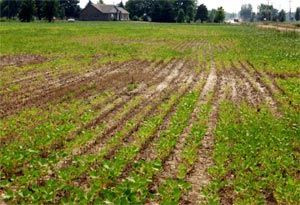
Each year, the largest single cause of loss in yield for North American and Michigan soybeans is the soybean cyst nematode (SCN). This small, plant parasitic pest feeds on roots and removes plant nutrients, disrupting water and nutrient uptake, resulting in retarded root growth. Plants that have high SCN numbers have poorly developed root systems that result in yellow, stunted plants, or may have no symptoms at all. In fact, scientists throughout this region have observed many research trials in which resistant and susceptible soybean varieties show no consistent differences in plant growth in fields known to be infested with SCN.
Producers that have soybeans in their rotation should consider splitting their soil samples taken during the fall to be analyzed for soil nutrients to also test for SCN. The Michigan Soybean Promotion Committee (MSPC) funds the cost of analyzing for SCN through the Soybean Checkoff. There is a limit of 20 analyses per farmer per year.
The following instructions should be followed for SCN soil sampling:
- Use a cylindrical soil probe to collect samples.
- Collect samples at a depth of 6-8 inches deep making sure to sample in the row.
- Collect 20 samples in a zigzag pattern. Place the samples in a plastic bucket and mix thoroughly for a composite sample. Research shows that 20 well-taken samples per composite will result in more repeatable test results compared to samples with five to 10 samplings per composite.
- Sample fields according to soil texture zones.
- Take the composite soil sample and place about 1 quart of it in a plastic bag. Store in a cool area away from sunlight until shipment can be made to the laboratory.
- Send to the Michigan State University Diagnostic Services Laboratory. Detailed instructions can be found at the Diagnostic Services website.
Once samples have been submitted and you have confirmation of SCN on your farm, there are some steps that can help manage the risk of this yield-robber. With proper SCN management, soybean production can remain profitable. For more in-depth information regarding SCN management, go to the Soybean Cyst Management Guide.
Recommendations for managing SCN:
- Rotating with non-host crops and lengthening the time between soybean crops will help to reduce number of SCN in your fields.
- Rotate sources of soybean resistance in the varieties you use. Don’t use the same one two years in a row.
- Relieve stress with good management of weeds, water and soil fertility.
- Avoid transporting SCN-infested soil from field to field on machinery.
Source : msu.edu